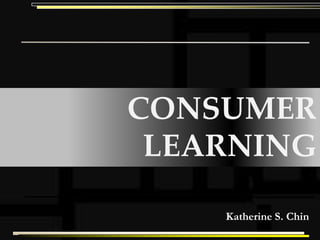
Consumer Learning
- 1. CONSUMER LEARNING Katherine S. Chin
- 2. Consumer Learning ► process that continually evolves and changes as a result of newly acquired knowledge or through actual experience. ► knowledge or experience may be acquired through reading, thinking, observation, discussion, action or interaction.
- 3. Learning occurs when an individual would show a relative and permanent change of behavior in a situation as a result of practice and experience and as a product of knowledge.
- 4. Classical Conditioning also called Pavlovian conditioning, created by Ivan Pavlov a theory he tested with a help of a dog and a bell
- 5. Classical Conditioning is a form of learning in which one stimulus, the conditioned stimulus or CS, comes to signal the occurrence of a second stimulus, the unconditioned stimulus or US. The US is usually a biologically significant stimulus such as food or pain that elicits a response from the start; this is called the unconditioned response or UR. The CS usually produces no particular response at first, but after conditioning it elicits the conditioned response or CR.
- 6. Components of CC 1. Unconditioned Stimulus (UCS) A stimulus that without conditioning will elicit a predictable response. 2. Unconditioned Response (UCR) A response that without conditioning will result predictably from UCS.
- 7. 3. Neutral Stimulus (NS) A stimulus that does not elicit the UR. Also called Orienting Stimulus (OS). 4. Conditioned Stimulus (CS) A stimulus that will elicit a predictable response because of its previous pairing with a previously occurring reflex.
- 8. 5. Conditioned Response (CR) A predictable response to a stimulus that has influence because of its previous pairing with a previously occurring reflex.
- 9. Diagram of Conditioning Process Before Conditioning UCS UCR meat dog
- 10. Diagram of Conditioning Process During Conditioning NS UCS UCR bell meat dog
- 11. Diagram of Conditioning Process After Conditioning CS CR bell dog
- 12. Use of Classical Conditioning in Marketing Techniques Creates awareness to the presentation of stimulus due to the presentation of previous conditioning stimulus (product) that would elicit emotional response in consumers.
- 13. Marketing Techniques using Classical Conditioning Principles Conditioning Responses to New Stimuli UC CS EXAMPLES Exciting Event A product or Theme New product Song advertised in a big event (concert, rallies) Patriotic Events or A product or person Patriotic music as Music background in commercials
- 14. Use of Familiar Stimuli to Elicit Responses CS CR EXAMPLES Popular Music Relaxation, Christmas Songs in retail excitement, good will stores Familiar Voices Excitement, attention Movie star narrating a commercial Sexy Voices, Excitement, Calvin Klein, Victoria’s Bodies attention, arousal Secret Familiar Cues Excitement, Siren sounding, telephones attention, anxiety or doorbells in commercials Familiar Social Feelings of Televisions advertisement Cues friendship and love depicting calls from family
- 17. Operant Conditioning Created by B.F. Skinner Also called Reinforcement Theory The process of strengthening the S-R pattern by immediately following the response with the reinforcement stimulus. Reinforcement is any stimulus that will maintain or increase the strength of a response.
- 18. Skinner’s Two Kinds of Learning 1) Respondent Conditioning (Classical Conditioning) It refers to a particular paired stimulus (bar press and food pellets) that consistently elicits the response. 2) Operant Conditioning This is voluntary behavior or a class of responses which is emitted or reinforced, thereby increasing the probability of responses.
- 19. Skinner’s Types of Reinforcement 1) Positive (Reward) This is a stimulus that when presented, acts to strengthen the behavior that it follows. 2) Negative This is a stimulus which when presented, acts to diminish or extinguish the behavior that follows. Extinction is a good example of negative reinforcement. 3) Punishment a. it is the withdrawal of a positive reinforcer. b. it is the presentation of a negative reinforcer or aversive stimulus.
- 22. Schedules of Reinforcement 1) Ratio – it is based on the number of responses emitted. The response is reinforced only to a certain proportion of the occasion where it occurs. Types of Ratio a) Fixed Ratio (FR) The reinforcement is contingent upon the occurrence of a fixed number of responses. b) Variable Ratio (VR) The number of responses required for reinforcement varies about some mean or average.
- 23. Schedules of Reinforcement 2) Interval- refers to reinforcement given at interval or passage of time . Types of Interval a) Fixed Interval (FI) The reinforcement occurs on a fixed time schedule. b) Variable Interval (VI) The length of time varies about some given mean time. Reinforcements becomes available at variable intervals.
- 24. Thank You
